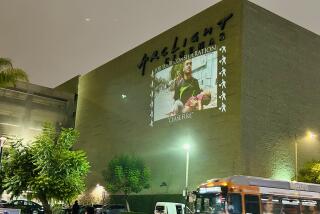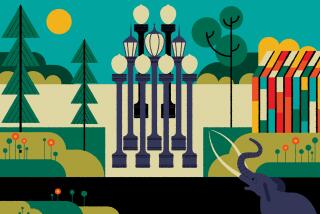L.A. Cultural Sites Exhibit Cases of Post-Riot Anxiety : Museums: The attendance apocalypse never happened, though the effects of the unrest are apparent.
Three days after the riots, a sizable crowd moved through the Los Angeles County Museum of Natural History, admiring the allosaurus and poking the giant roaches in the insect zoo.
But no one took that as a sure sign of a rosy future for culture in post-riot Los Angeles: Virtually all the visitors were camouflage-clad National Guardsmen, bivouacked there in Exposition Park.
Throughout May, attendance at museums and similar attractions plunged in what potential visitors perceived to be the riot zone. Schools rushed to cancel field trips. Dire predictions were voiced about the fate of cultural institutions and the arts in Los Angeles.
By all indications, however, the attendance apocalypse never happened, though the effects of the unrest are apparent. Visits are down substantially at a number of cultural sites, up at a number of others, and still others are hanging tough.
“In general, I think attendance is down,” said Adolfo V. Nodal, general manager of the city’s Department of Cultural Affairs. “From all I hear . . . people say audiences are slow to return.”
But not everyone says that. The Imax Theater in Exposition Park is inexplicably blowing away attendance records, boasting 12,700 more visitors this July than last.
A few steps away, the California Afro-American Museum experienced a brief, anxiety-inducing drop in visitors after the riots, which had raged nearby. But within days--thanks in part to an aggressive publicity campaign--record crowds flocked to “Songs of My People,” a traveling exhibit of photographs by African-American photographers.
Ivan Nossoff, a spokesman for the California Museum of Science and Industry, attributes the quick comeback of Exhibition Park venues to public confidence. “People know about our friendly and visible security staff,” he said. “They like it. They like the Smokey the Bear hats.”
Other places have not fared so well.
Oddly, downtown--which remained relatively calm after the first violent explosion on April 29--appears to be harder hit than places closer to where buildings burned and people died.
The Children’s Museum suffered from erroneous television reports that the place had burned to the ground. School groups continued canceling trips well into the summer; overall, attendance is down 20% compared to last year.
A few blocks away, the Japanese American National Museum is hard pressed to figure out how attendance was affected. Its scheduled grand opening was April 30, the day after the verdicts in the Rodney King beating case were announced.
“We essentially opened at the same time all hell broke loose,” said Chris Komai, public relations coordinator at the museum.
Even long-established institutions are struggling to sort out how much damage the riots did because so many other forces were already assaulting attendance figures.
Visitors have been staying away from the Museum of Neon Art on Traction Avenue for about three years, said director Mary Carter. She blames the downturn on “the general decline of downtown. People are afraid to come downtown. They’re afraid to park on our street. There are a lot of panhandlers . . . . That was all before the riot, but the riot was really the coup de grace. “
The museum intends to move to the Universal City CityWalk complex next year.
Other institutions are trying to make the most of the post-riot environment. The Children’s Museum, Central Library and other organizations are developing a series of events to address issues of ethnic diversity.
The staff at Hebrew Union College’s Skirball Museum, at 32nd Street and Vermont Avenue, rallied immediately after the rioting to keep schools from canceling their tours. They dropped the usual admission fee and touted the increased significance of the Jewish cultural museum’s multicultural programs.
Meanwhile, the African-American Museum will be the first institution to directly test whether there might be a silver lining for attendance in the riots.
On Sept. 25, it launches an exhibit of 21 black artists’ interpretations of the unrest titled: “No Justice, No Peace?”
More to Read
The biggest entertainment stories
Get our big stories about Hollywood, film, television, music, arts, culture and more right in your inbox as soon as they publish.
You may occasionally receive promotional content from the Los Angeles Times.










